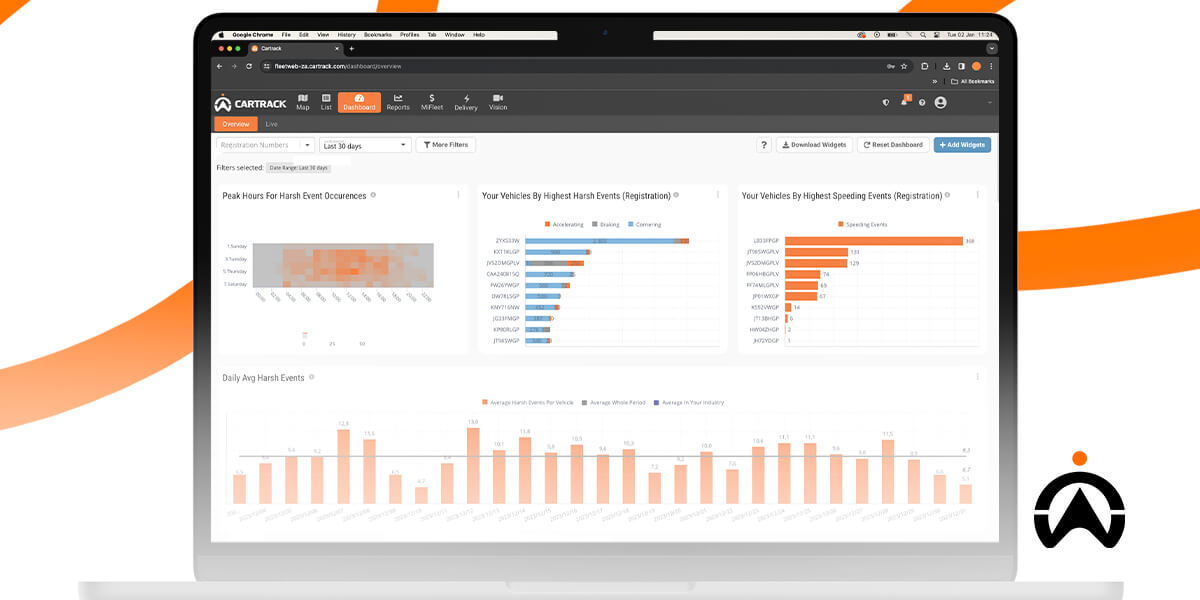- Solutions
- The Company
- About usCartrack offers smart fleet solutions guaranteed to optimise your fleet and workforce, no matter how big or small your business.
- Investor RelationsCartrack has a history of strong cash flow generation and cash conversion, low financial leverage and strong dividends.
- CareersCareers portal. View all the current Cartrack career openings and opportunities available.
- Resources
- Contact Us
- Bahasa
- Login
G-force - The Remarkable Science Of Monitoring Harsh Driver Behaviour

---- 2024/02/26 ---
What is g-force?
A g-force, often referred to as a gravitational force, is defined as a measure of acceleration. In simpler terms, it is how much you are pushed or pulled when you accelerate, brake, or turn. When we stand on the ground, the weight and force that prevent us from floating away are equivalent to one "g." This measurement serves as a metric to quantify any form of acceleration, making it important in various fields, including aviation, the military, and the fleet industry.
What is harsh driving?
Harsh driving can be defined as any sudden change in the direction or speed of a vehicle or truck going at a steady rate. It is often noted as sudden changes in g-forces that can be monitored by an accelerometer, a device that measures changes in the speed or direction of a moving body (in this instance, a vehicle).
When an accelerometer is at rest, it measures one g-force, which is the force of gravity acting on it. When the accelerometer is in motion, it measures the difference between the force of gravity and the force of acceleration acting on it. The accelerometer measures acceleration in meters per second squared (m/s²), and this can be converted to g-force by dividing the acceleration by the acceleration due to gravity (approximately 9.81 m/s²).
Accelerometers are widely used in transportation, including in airbags, where they detect sudden changes in a car’s speed, signalling an imminent collision, and trigger an electric circuit that makes the airbags inflate.
How does g-force relate to harsh driving?
Harsh driver behaviour is typically expressed in terms of g-force due to its role in monitoring the behaviour. This is done by measuring the magnitude of acceleration and deceleration a vehicle experiences. Due to harsh driving that subjects a vehicle to abrupt changes in speed, direction, or both, a sudden increase in g-force experienced by the driver, passengers, and the vehicle itself is a key indicator of harsh driving.
Harsh driving is expressed in terms off g-force, due to it playing a crucial role in measuring the magnitude of acceleration or deceleration that a vehicle experiences.
What are the different forms of harsh driving?
Harsh driving is a broad term used to describe a range of driving behaviours. Here are the four most common forms of harsh driving:
- Harsh braking: Harsh braking is when a driver uses more force than necessary to stop a vehicle. While there are some understandable instances where hard braking cannot be avoided (such as stopping to prevent an accident), unnecessary hard braking may suggest distracted driving, as it is a common effect of drivers failing to maintain a safe following distance. This increases the chances of a rear-end collision, as there isn’t enough following distance to allow for sudden yet safe deceleration.
- Harsh acceleration: Harsh acceleration is when drivers use more power than necessary to move their vehicle after coming to a stop. Frequently seen when drivers are waiting at a traffic light and slam the accelerator to get moving as quickly as possible, when drivers quickly accelerate in an attempt to beat a red traffic light, or when drivers aren’t paying attention to traffic flow and have to speed off from a stop line, harsh acceleration can be indicative of distracted driving. It often suggests a lack of focus, impatience, or an attempt to compensate for lost time while not paying attention to traffic signals or the surrounding environment.
- Harsh cornering: Also referred to as sharp cornering, harsh cornering is defined by a driver accelerating through a turn, which causes them to turn the corner too fast. This is quite dangerous, as it puts more force on the vehicle’s tires. This means a driver can lose control of the vehicle entirely, leading to accidents with other vehicles. On top of that, it puts top-heavy vehicles at risk of flipping. It also leads to limited visibility of the road beyond the bend, which puts drivers at risk of encountering obstacles.
- Lane drifting: Lane drifting is defined by a driver unintentionally drifting out of their lane and crossing into another lane or onto the shoulder of the road. When a driver diverts their attention away from the road, even momentarily, their likelihood of lane drifting is greatly increased. This is dangerous, as it increases the likelihood of collisions with adjacent vehicles and poses a risk to oncoming traffic. It can indicate distracted driving, as taking your eyes off the road can cause you to drift. It can also indicate a lack of proper following distance, increasing the risk of rear-end collisions.

How does harsh driving impact fleets?
Harsh driving can have significant negative impacts on fleet vehicles that not only affect safety but overall fleet efficiency. Here’s how:
- It reduces fleet vehicle lifespan: Harsh driving significantly impacts the longevity of fleet vehicles in the following ways:
- It increases tire wear: Harsh acceleration forces the tires to grip the road intensely, leading to an increase in friction and heat generation. This excessive stress leads to premature tire wear, which reduces tread life and compromises the tire’s structural integrity. Harsh braking can also cause uneven wear patterns on their tires, diminishing their lifespan and necessitating more frequent replacements.
- It increases brake system strain: Frequent harsh braking leads to increased wear on brake pads, and this intense friction results in decreased brake pad lifespan, which compromises vehicle safety.
- It increases suspension system strain: Harsh driving puts a strain on the vehicle’s suspension parts, such as shocks, struts, and bushings, which reduces their effectiveness. These components are important for maintaining vehicle stability and proper functioning of the steering system, which makes your vehicles more susceptible to mechanical failures.
- It increases your fleet’s fuel consumption:
Harsh driving has been shown to increase the amount of fuel your vehicle burns in the following ways:
- It increases fuel consumption due to downshifting: Harsh braking has been shown to drastically raise your vehicle’s fuel consumption, thereby diminishing fuel mileage. When a driver brakes harshly, a vehicle’s transmission downshifts to the lowest gear. While this downshifting is necessary to compensate for the sudden decrease in speed, lower gears require more engine revs to maintain movement, which means more fuel is burned. Tests have indicated that aggressive driving can increase fuel consumption by approximately 40%.
- It diminishes fuel mileage: The increased fuel consumption resulting from harsh driving negatively affects your fleet’s fuel mileage. A study by the Oak Ridge National Laboratory indicated aggressive driving can reduce fuel economy by 15%-30%.
- It reduces tire performance:
Harsh driving can have the following negative impact on your vehicle’s tire performance:
- Causing uneven wear: Harsh driving contributes to uneven resistance on the tires. Harsh acceleration causes tires to struggle against intense friction, unevenly wearing the tread down. Harsh braking also forces the tires to work against the road surface, resulting in uneven wear patterns that diminish tire life.
- Causing flat-spotting: Harsh braking can lead to flat-spotting, which occurs when tires skid or lock up, causing them to slide across the pavement. This wears down specific parts of the tire tread more rapidly than others, creating uneven wear patterns and reducing the tire’s effectiveness and life span.
- Increasing heat build-up: Harsh driving generates excessive friction, which leads to increased heat build-up in tires. Tire overheating accelerates the deterioration of tire rubber compounds and makes them more susceptible to blowouts and structural damage.
- It increases the risk of collisions:
Harsh driving increases the risk of vehicle collisions in the following ways:
- Increasing risk of rear-end collision: Harsh driving reduces the safe following distance between vehicles, decreasing the driver’s ability to respond to sudden changes in traffic flow, and increasing the risk of collisions
- Reducing response times to potential hazards: Harsh driving compromises a driver’s ability to respond promptly to unforeseen situations, such as a vehicle suddenly changing lanes, pedestrians unexpectedly crossing the road, or obstacles on the road. This reduction in response times increases the likelihood of accidents as the driver doesn’t have enough time to avoid potential road dangers.
- Compromising vehicle stability and control: Harsh driving destabilises a vehicle, which affects its handling capabilities. This makes it more difficult to manoeuvre safely, especially in emergencies where drivers need to quickly adjust their driving and take sudden actions. This compromised control significantly increases the risk of accidents.
- It increases fleet maintenance costs:
Harsh driving increases your fleet’s maintenance costs by:
- Increasing wear and tear on vehicle components: Harsh driving behaviour places strain on critical vehicle parts such as brakes, tires, suspension systems, transmission, and engine components. This leads to premature strain being placed on these components, causing them to wear out sooner than planned. This means fleet managers need to allocate more time and resources for frequent servicing, part replacements, and repairs, which leads to unplanned vehicle downtime and increased maintenance costs.
- It harms driver performance:
Harsh driving affects your driver’s performance in the following ways:
- It reduces their response time: Harsh driving behaviour diminishes a driver’s ability to quickly react to unexpected situations, leading to delayed reactions that increase the likelihood of accidents.
- It increases their stress levels: Harsh driving has been shown to induce physiological stress responses, which heighten driver anxiety and tension. This increase in stress not only affects driver’s mental well-being but also impairs their cognitive function, which affects decision-making abilities and reaction times.
- It increases fatigue: The physical strain caused by harsh driving, such as harsh acceleration, braking, and steering, can increase driver fatigue. Over time, this constant strain contributes to increased exhaustion and reduced focus, especially during long-distance journeys. This decreases your driver’s situational awareness and impairs their judgement, heightening the potential for accidents.
To pick up on harsh driving, you need to keep a close eye on your fleet driver’s behaviour. While this may seem like a challenge, a driver monitoring system is your key to simplifying the entire process.
What is a driver monitoring system?
A driver monitoring system is an advanced vehicle safety technology that combines hardware and software to consistently track and assess driver behaviour, attentiveness, and overall condition while they’re behind the wheel. This cutting-edge technology combines sensors, cameras, and advanced data processing mechanisms that work to conveniently give you unparalleled access to fleet driver behaviour. The primary objectives of this safety-focused system are to enhance safety, prevent accidents caused by driver distraction or fatigue, improve overall driver performance, and boost overall fleet efficiency.
How does driver monitoring work?
Driver monitoring systems are very intricate, utilising a wide range of components that work together to effectively monitor driver behaviour. These components include:
- Cameras: Cameras are the foundation of driver monitoring systems. By making use of driver-facing cameras that are equipped with infrared light-emitting diodes, the systems can track the driver’s head position, eye movements, and facial expressions. These cameras are also equipped with advanced AI algorithms that work to continuously analyse driver behaviour, and pick up on signs of distraction, drowsiness, or impairment.
- GPS tracking: GPS tracking is another crucial component of driver monitoring systems. By leveraging GPS tracking, fleet managers gain access to data on driver routes, stop locations, and the real-time location of their vehicles. This comprehensive video of a vehicle’s movements provides valuable insight into driver behaviour, such as speeding, idling, or unauthorised detours.
- Driver Scorecards: Driver scorecards are comprehensive performance evaluation tools that can assess driver behaviour within a fleet. These give fleet managers detailed insights into individual driver behaviour, encompassing factors such as speed compliance, harsh braking, and adherence to designated routes.
- Data processing and analysis: Data processing and analysis are integral to effective driver behaviour monitoring. By collecting and presenting a wide range of data related to driving patterns, vehicle movements and location, this system helps fleet managers detect patterns, easily identify instances of harsh driving,

What are the benefits of a driver monitoring system?
While the main reason for implementing a driver monitoring system could be to eliminate harsh driving, this system yields a wide range of benefits that positively impact your entire fleet operation. These benefits include:
- Improving fleet driver safety: Driver monitoring systems provide a combination of hardware and software that monitors driver behaviour around the clock. This advanced software works to detect signs of distraction, drowsiness, and fatigue, which makes it crucial to prevent accidents from occurring, as these behaviours can significantly increase the risk of accidents.
- Reducing the risk of accidents: A driver monitoring system helps prevent potential accidents by identifying and alerting drivers about their distracted or fatigued behaviour while they’re behind the wheel. These behaviours significantly increase the risk of collisions and loss of vehicle control. When these signs are detected, the system can issue alerts to the driver, prompting them to refocus their attention.
- Lowering fleet maintenance costs: By promoting smoother and safer driver habits, driver monitoring systems help reduce wear and tear on vehicle components. Extending the lifespan of brake components, suspension systems, and tires, directly translates to a decrease in maintenance and repair costs.
- Improving fleet fuel efficiency: Driver monitoring systems work to detect and alert drivers to various fuel-wasting driving behaviours, such as excessive idling, harsh acceleration, and speeding. This helps drivers promptly fix their behaviour, playing a significant role in improving your fleet’s fuel efficiency. This contributes to cost savings by reducing fuel consumption across your entire fleet.
- Improving overall fleet efficiency: Driver monitoring systems significantly reduce accidents, which means decreased downtime. Decreased downtime due to accidents or breakdowns allows for uninterrupted fleet operations, which ensures the timely completion of tasks, deliveries, or services. This leads to increased customer satisfaction and loyalty, improving overall fleet efficiency.
Gain unparalleled insights into driver behaviour with Cartrack’s driver monitoring system
Cartrack is here to bring a world-class driver behaviour monitoring system right to your fleet. Equipped with a wide range of technologies that help you take your driver behaviour to the next level, our system is just what you need to improve your fleet driver’s behaviour and reap the benefits of safe fleet functioning. These include:
- ADAS
Keep your drivers aware of their surroundings with Cartrack’s Advanced Driver Assistance System (ADAS). This is a technology that is designed to enhance fleet safety and efficiency. By alerting your drivers to potential road hazards, detecting and responding to obstacles, and helping them maintain a safe distance from other vehicles, ADAS works to heighten your drivers’ awareness of their surroundings.
These functionalities are made possible through the integration of camera-based sensors, artificial intelligence, and intelligent algorithms, which all work together to provide driver assistance features that enhance driver safety. These include:
- Data processing
- Driver assistance features, including:
Automatic emergency braking: This feature quickly identifies potential collisions and automatically engages the vehicle’s brakes. This helps to either minimise the impact or prevent the collision entirely.
Forward collision warning: This feature quickly alerts your drivers when their vehicle is approaching an obstacle or vehicle too quickly, which can help them prevent rear-end collisions.
Blind-spot detection: This feature quickly alerts your drivers to vehicles that are in blind spots, helping them reduce the risk of lane-changing accidents.
- Live Vision AI cameras
Gain 24-hour visual access to your fleets with Cartrack’s Live Vision AI cameras, an AI-powered, live streaming technology. This cloud-connected video management solution makes use of AI analysis to give you access to driver behaviour monitoring and real-time alerts. This technology can also detect various forms of distracted or dangerous driving, including:
- Speeding
- Smoking
- Fatigue
- Cell phone useWhen any of the above behaviours are detected, audible in-cabin audio alerts are triggered, immediately notifying your drivers. This helps them correct their actions in real time, preventing potential accidents from taking place. What’s more, fleet managers can also receive these real-time alerts and access the footage via a livestream feed, which helps them ensure that preventative action is immediately implemented.
- Driver scorecards
Get an overview of each of your drivers and their behaviour with Cartrack’s driver scorecards, helping you determine how safely they drive. This is done by keeping track of any high-risk behaviours, such as
- Harsh acceleration
- Harsh braking
- Excessive idling
- Excessive speedingThese scorecards help you identify the specific areas drivers need coaching in. They help you provide them with specific training to help them improve their behaviour behind the wheel. This is a very crucial part of an effective driver monitoring system, as it helps you pinpoint specific indicators of harsh driving, along with the drivers who perform these behaviours.
- Fuel monitoring
Keep track of your vehicle’s fuel levels and quickly spot harsh driving with Cartrack’s fuel monitoring system. Our real-time fuel level monitoring makes use of advanced sensors installed inside fuel tanks, which enable the live monitoring of fuel consumption through our fleet management platform. By helping you conveniently monitor fuel levels as changes occur, you can quickly identify sudden spikes in fuel consumption, which could be indicative of harsh driving, with behaviours such as excessive idling, speeding, and harsh braking contributing to increased fuel consumption.
- Crash detection
Ensure your drivers receive immediate assistance in the event of a car crash or accident with Cartrack’s crash detection. As much as your drivers can implement safe driving strategies, this doesn’t guarantee that other drivers will exercise the same vigilance and safe driving habits on the road. By making use of our smart device that detects a crash or accident by making use of special g-force sensors and AI algorithms, we can detect and pinpoint the exact location of accidents in real time. This enables us to quickly contact you and dispatch emergency services to your driver’s live location if they are involved in a car crash or accident.
Let Cartrack help you streamline your driver behaviour monitoring today
Are you ready to establish a safety-first driving culture in your fleet? Embark on the journey to improved driver safety with Cartrack and gain access to world-class technologies.
Contact us today, and embrace improved driver safety for your fleet.













 Select Countries
Select Countries